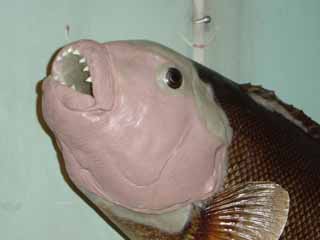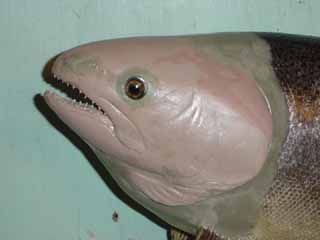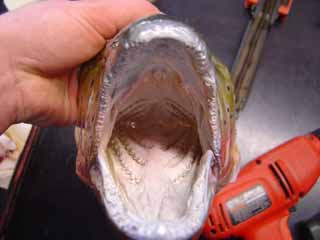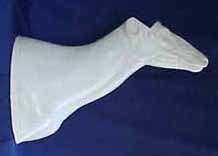presents
Molding & Casting Large Fish Heads Part II - Mouth Detail By Professional Fish Taxidermist Aaron N. Stehling
Molding & Casting Dept.
N4027 Hwy N
Jefferson, Wisconsin 53549
Ph. 1-920-674-3724
Sponsored by WHITETAIL DESIGNER SYSTEMS, INC
TAXIDERMY TANNING SUPPLIES
One way to get the full mouth detail is to use a mouth plug. You could make a plug, and add this to your head mold using the process I outlined in the Molding & Casting Large Fish Heads article and then make a permanent RTV rubber mold from that prototype. Here is my method for molding and casting mouth plugs:
You could use alginate or rubber for this, it's up to you. If your going to use alginate, use the best brand you can find. I would recommend removing all the large canine teeth from your fish. These can be recreated with epo-grip fish tooth, or a similar product. The smaller teeth along the roof of the mouth can stay in most cases, but I sometimes grind these off with a dremel- it can make for an easier "pull".
When we cast mouth detail, we set the head up vertically with the body of the fish supported in a box (the head facing up toward the ceiling). We staple the throat also so we do not waste alginate or rubber. Cut a mixing type container down one side and insert it in mouth a small ways. Tape gill covers shut and tape around the open mouth, leaving no gaps. Mix your alginate or rubber and slowly pour in mouth until it fills up to the top of the mixing container you added to inside lip of mouth.
When product has set, take tape off and slowly work "plug " out of mouth. If you used alginate, use extra care as not to damage it.
If you used alginate, you can get one good cast before mold breaks. If you used rubber, you have a permanent mouth plug mold.
If your mold was alginate, mix up 50/50 bondo resin and coat the plug. Repeat this a number of times to get strength.
Let cure and remove. You will probably have to wreck the mold in order to remove the cast.
If you used a rubber mold, you can cast your plug from a number of different materials. Apoxie, urethanes, bondo/resin , hot glue, five minute apoxie, latex, etc.
We use a little mold release to aid in removing the plug.
Now, another method that works equally well is to make a single mold of the exterior of the head and full, seamless mouth detail. When I do this, I cut the head completely away from the carcass (including the collar bones and throat latch) and set the head up in a high fiber type support system, basically replacing the body area with high fiber.
Another option is to set the head up the way I outlined in the original article, with the head portion of the carcass still attached. I then pack High Fiber under the gill covers so the gills are open to my desired flare. I then bring this high fiber down over the rest of the carcass flush with the support board, basically covering the carcass portion of my fish with high fiber. This will stop any alginate or rubber from leaking out under the gills. It makes it quite easy to keep a uniform gill flare, and achieve seamless mouth detail.
I then proceed to cast the head as explained in the article. You can use alginate, or if your head is fresh, you can use RTV rubber and make a permanent mold right off the original head. When I demold my head, I may have to cut the gills and remove them one by one from the mold material. This makes demolding of your organic head MUCH easier. This may be the easiest way to get started in permanent mold making with full, seamless mouth detail.
I would recommend a high quality urethane or bondo/resin mix to cast heads from your permanent mold.



Picture # 1 is of a Blackfish, head was cast using the method outlined in the original Molding & Casting Large Fish Heads article.
Picture # 2 is of a Steelhead cast using the "seamless mouth detail " method outlined above( alginate mold).
Picture # 3 is of a steelhead cast from a permanent rubber mold.
Striper Head fresh out of the alginate mold.
Completed steelhead using an alginate mold.
Here's a couple more fish taxidermy articles you may find of interest:
The entire line of WHITETAIL DESIGNER SYSTEMS products can be purchased direct by calling our sales rep, Franz Heepe. Tanning supplies, taxidermy reference photos, STOP-ROT.
Phone TOLL FREE 1-877-861-5679.
TAXIDERMY TANNING SUPPLIES
RESEARCH MANNIKINS also offers on-line purchasing of all WHITETAIL DESIGNER SYSTEMS PRODUCTS for your convenience.
STOP-ROT is available on-line from high lighted suppliers! RESEARCH MANNIKINS 1-800-826-0654,
AEWS Taxidermy Supplies 1-800-529-3470.

Keep up with the growth of the REAL DEER FORMS by Glen Conley by visiting www.realdeerforms.com.
6 3/4" nose to eye x 16" neck circumference, right behind the ears, semi-sneak straight form pictured.
REAL DEER FORMS are available through Quality Taxidermy Supply. Current availability and price list of REAL DEER FORMS .